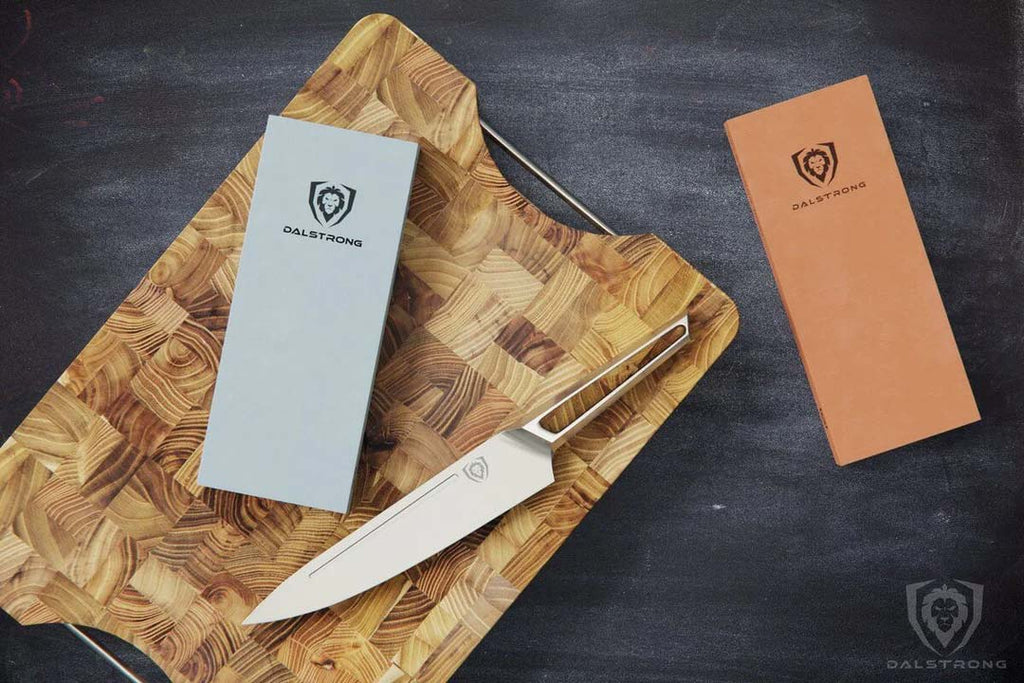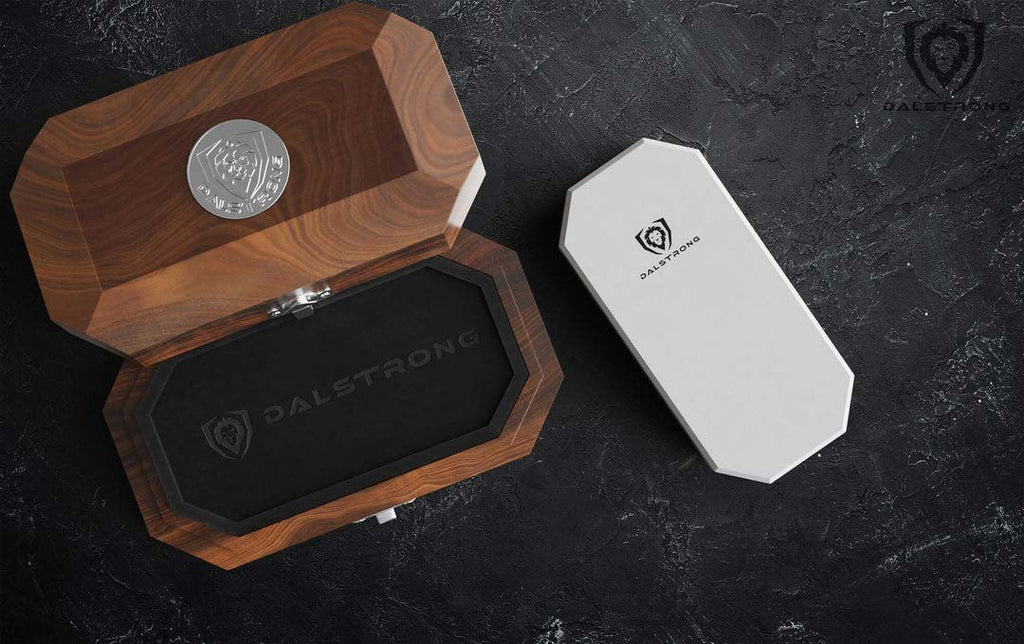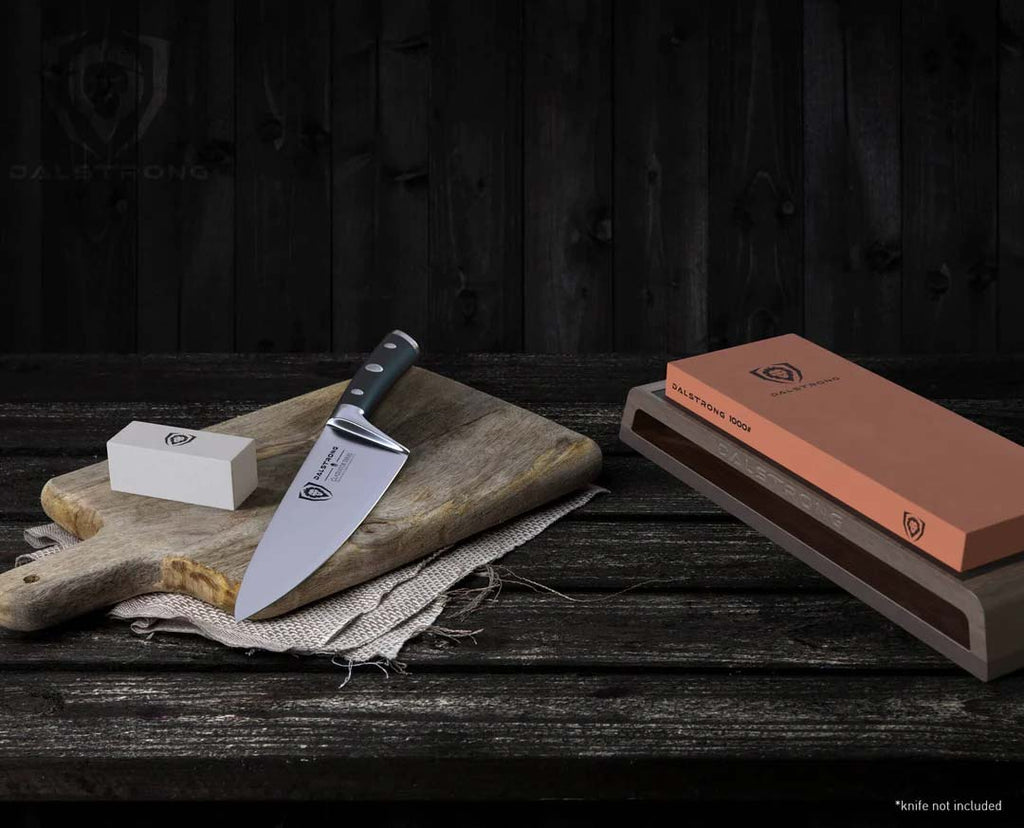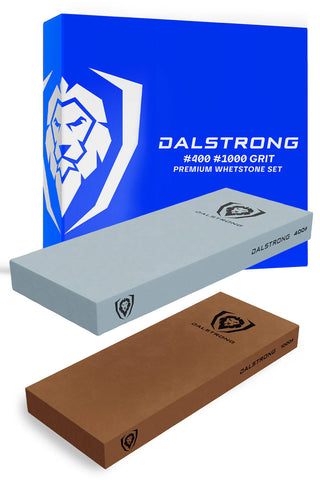Sharpening A Knife With A Stone

Premium Whetstone Set #400 / #1000 Grit
Knife sharpening with a stone is an essential skill, ensuring blades remain razor-sharp for optimal performance. This traditional method offers precision and control, revitalizing dull edges with ease. By mastering this technique, you empower yourself with the ability to maintain and enhance the longevity of your knives. Join us as we delve into the art of sharpening, exploring the simplicity and effectiveness of using a stone to achieve unparalleled sharpness.
1. Different Types Of Sharpening Stones
 Portable Whetstone Kit #1000 / #6000 Grit Combo with Oak Storage Box
Portable Whetstone Kit #1000 / #6000 Grit Combo with Oak Storage Box
When it comes to sharpening stones, diversity is the spice of life—or, in this case, the key to a keen edge. From the rugged grit of natural stones to the consistent performance of synthetic ones, there's a world of options to explore. Natural stones like Arkansas, Belgian Blue, and Japanese waterstones offer unique textures and nuances, each with its own character and charm. Meanwhile, synthetic stones, such as diamond, ceramic, and aluminum oxide, provide reliable grit levels and durability for consistent sharpening. Whether you're drawn to the earthy allure of natural stones or the reliability of synthetics, each type has its place in the arsenal of the discerning sharpener, ready to transform a dull blade into a gleaming masterpiece.
2. How To Prepare Your Knife For Sharpening
 Premium Whetstone Kit #1000 / #6000 Grit with Nagura Stone & Rust Eraser
Premium Whetstone Kit #1000 / #6000 Grit with Nagura Stone & Rust Eraser
Preparing your knife for sharpening is like laying the groundwork for a masterpiece—it sets the stage for a keen edge that slices through anything with ease. Here's a step-by-step guide to get your blade ready for sharpening:
- Clean the Knife: Start by giving your knife a good scrub with soap and water to remove any dirt, grime, or food residue clinging to the blade. Make sure to dry it thoroughly afterward to prevent rust.
- Inspect for Damage: Take a close look at the blade under good lighting. Check for any nicks, chips, or dings along the cutting edge. If you spot any imperfections, note their locations—you'll need to address them before sharpening.
- Address Any Imperfections: For minor nicks or dings, you can often smooth them out with a honing steel or a fine-grit sharpening stone. If the damage is more severe, you may need to use a coarse grit stone or file to gently reshape the blade.
- Secure Your Knife: Place a damp towel or non-slip mat on your work surface to prevent the knife from sliding around. Make sure the knife is securely held in place to avoid accidents during sharpening.
- Choose Your Sharpening Stone: Select the appropriate sharpening stone based on your knife's needs and your sharpening skill level. Coarse stones are best for repairing damage or reshaping the blade, while finer stones are ideal for honing and polishing the edge.
- Get Ready to Sharpen: Before you begin sharpening, ensure that you have a comfortable and stable grip on both the knife and the sharpening stone. Maintain a consistent angle between the blade and the stone throughout the sharpening process.
By following these steps, you'll have your knife primed and ready for sharpening, setting the stage for a blade that's as sharp as can be.
Read about how to clean a knife, here.
3. Sharpening Techniques With A Stone
Sharpening a knife with a stone is like conducting a symphony—it requires finesse, precision, and a good ear for harmony. There are several techniques you can use to achieve a razor-sharp edge, each with its own rhythm and flow. Here are a few to get you started:
The Edge Leading Stroke
This technique involves moving the knife blade across the stone with the cutting edge leading the way. Start by placing the knife at the desired sharpening angle on the stone, then gently push the blade away from you, maintaining consistent pressure and angle. Repeat this motion several times, alternating sides, until you've sharpened the entire length of the blade.
The Edge Trailing Stroke
In contrast to the edge leading stroke, this technique involves pulling the knife blade across the stone with the cutting edge trailing behind. Begin by placing the knife on the stone at the desired angle, then draw the blade towards you while maintaining pressure and angle. Repeat this motion several times, switching sides as needed, until the edge is sharp and polished.
Circular Motion
For curved or rounded blades, such as those on a chef's knife or a pocket knife, a circular motion can be effective. Start by placing the blade on the stone at the desired angle, then use a circular motion to move the entire length of the blade across the stone. Be sure to maintain consistent pressure and angle throughout the motion, and repeat as needed until the edge is sharp and even.
The Scissor Stroke
This technique is particularly useful for sharpening serrated blades, such as those on bread knives or steak knives. Start by placing the knife at the desired angle on the stone, then gently rock the blade back and forth, ensuring that each serration makes contact with the stone. Continue this motion until the entire edge is sharp and well-defined.
Whichever technique you choose, remember to take your time and maintain a steady hand. Like a maestro conducting an orchestra, the key is to find your rhythm and let the sharpening process unfold with precision and grace. With practice and patience, you'll soon be wielding a blade that's as sharp as it is beautiful.
4. Must-Have Dalstrong Whetstones
1. Whetstone Kit #1000 / #6000 Grit with Nagura Stone
Introducing the Premium Whetstone Kit #1000 / #6000 Grit, complete with a Nagura Stone and Rust Eraser—an essential toolkit for honing your blades to perfection. Crafted for both novice and seasoned sharpeners alike, this kit offers a comprehensive solution for achieving razor-sharp edges with unparalleled finesse.
PROS:- With two grit options (#1000 and #6000), this kit offers versatility for sharpening a wide range of blades, from kitchen knives to woodworking tools.
- Achieve professional-level sharpness and precision with the high-quality whetstones and accompanying tools, ensuring your blades are always ready for any task.
- Designed for both beginners and experienced sharpeners, the kit includes everything you need to get started, making the sharpening process intuitive and straightforward.
- Crafted from durable materials, the whetstones and accompanying tools are built to withstand regular use, providing long-lasting performance and value.
CONS:
- While the kit is suitable for sharpening enthusiasts of all levels, mastering the sharpening technique may require some practice and patience, especially for beginners.
2. Portable Whetstone Kit #1000 / #6000 Grit with Oak Storage Box
The Portable Whetstone Kit #1000 / #6000 Grit Combo with Oak Storage Box—an elegant and practical solution for sharpening your blades on the go. Crafted with convenience and functionality in mind, this compact kit ensures that your blades remain razor-sharp wherever your adventures take you.
PROS:
- With its compact size and portable design, this kit allows you to sharpen your blades anytime, anywhere, ensuring that your tools are always in top condition, even when you're on the move.
- The dual grit stones offer versatility for sharpening a wide range of blades, from kitchen knives to outdoor tools, providing everything you need for comprehensive blade maintenance in one convenient package.
- The oak storage box keeps all components organized and secure, preventing loss or damage during travel. Additionally, the non-slip base ensures stability during sharpening, even in outdoor environments.
- Enjoy professional-level sharpening results with the premium whetstones included in the kit, ensuring that your blades are always sharp, precise, and ready for any task.
CONS:
- The compact size of the whetstones may be less ideal for sharpening larger blades or tools, requiring more time and effort to achieve optimal results compared to larger stones.
3. Premium Whetstone Set #3000 / #8000 Grit
The Premium Whetstone Set #3000 / #8000 Grit—an exceptional toolkit for achieving razor-sharp edges and impeccable blade refinement. Crafted with precision and quality in mind, this set offers a superior sharpening experience for discerning sharpeners and professionals alike.
PROS:
- Achieve razor-sharp edges and superior blade refinement with the high-quality whetstones included in the set, ensuring that your blades are always in peak condition for optimal performance.
- The inclusion of both #3000 and #8000 grit stones allows for comprehensive sharpening and polishing, catering to all stages of the sharpening process and providing a flawless finish for your blades.
- Crafted from premium materials, these whetstones are built to withstand regular use and maintain their integrity over time, providing consistent sharpening results for years to come.
CONS:
- Sharpening technique may require some patience, especially for beginners who are new to using higher grit stones.
4. Premium Whetstone Set #400 / #1000 Grit
The Premium Whetstone Set #400 / #1000 Grit—a versatile sharpening toolkit designed to breathe new life into dull blades and keep them performing at their best. Crafted with quality and functionality in mind, this set offers a reliable solution for achieving sharp edges with ease.
PROS:
- Designed for both beginners and experienced sharpeners, this set is user-friendly and intuitive, making the sharpening process straightforward and hassle-free, even for those new to sharpening.
- Compared to higher grit stones, such as #3000 or #6000, this set offers a more budget-friendly option without compromising on quality, making it accessible to a wide range of sharpening enthusiasts.
- With two grit options available, you have the flexibility to tackle different sharpening tasks, from repairing damaged blades to refining edges to a razor-sharp finish, all in one convenient set.
CONS:
- While the #1000 grit stone provides a fine finish for sharpness, it may not achieve the mirror-like polish of higher grit stones, such as #3000 or #6000, for those seeking an ultra-refined edge.
5. Frequently Asked Questions
Is a sharpening stone better than a knife sharpener?
Sharpening stones offer greater control and precision, allowing users to tailor the sharpening process to their specific needs and blade types. They provide a more traditional and hands-on approach to sharpening, resulting in a finer and more consistent edge. While knife sharpeners are convenient, sharpening stones often deliver superior results, especially for those seeking professional-level sharpness and refinement.
What is the best stone for sharpening knives?
The best stone for sharpening knives depends on personal preference and the type of blade being sharpened. However, many sharpening enthusiasts recommend waterstones for their versatility, ease of use, and ability to produce razor-sharp edges. Additionally, diamond stones are valued for their durability and ability to sharpen even the hardest steels efficiently. Ultimately, the best stone varies based on individual needs and preferences.
Do stones sharpen knives?
Yes, sharpening stones are highly effective tools for sharpening knives. They work by removing material from the blade's edge, creating a new, sharper edge. By applying consistent pressure and maintaining the correct angle, users can achieve precise and razor-sharp results. Sharpening stones come in various grit levels, allowing users to customize the sharpness and finish of their blades.
Do sharpening stones work?
Yes, sharpening stones are effective tools for sharpening knives and other blades. They work by removing material from the blade's edge, creating a new, sharper edge. By applying consistent pressure and maintaining the correct angle, users can achieve precise and razor-sharp results. Sharpening stones come in various grit levels, allowing users to customize the sharpness and finish of their blades.































































































































































































































































































































